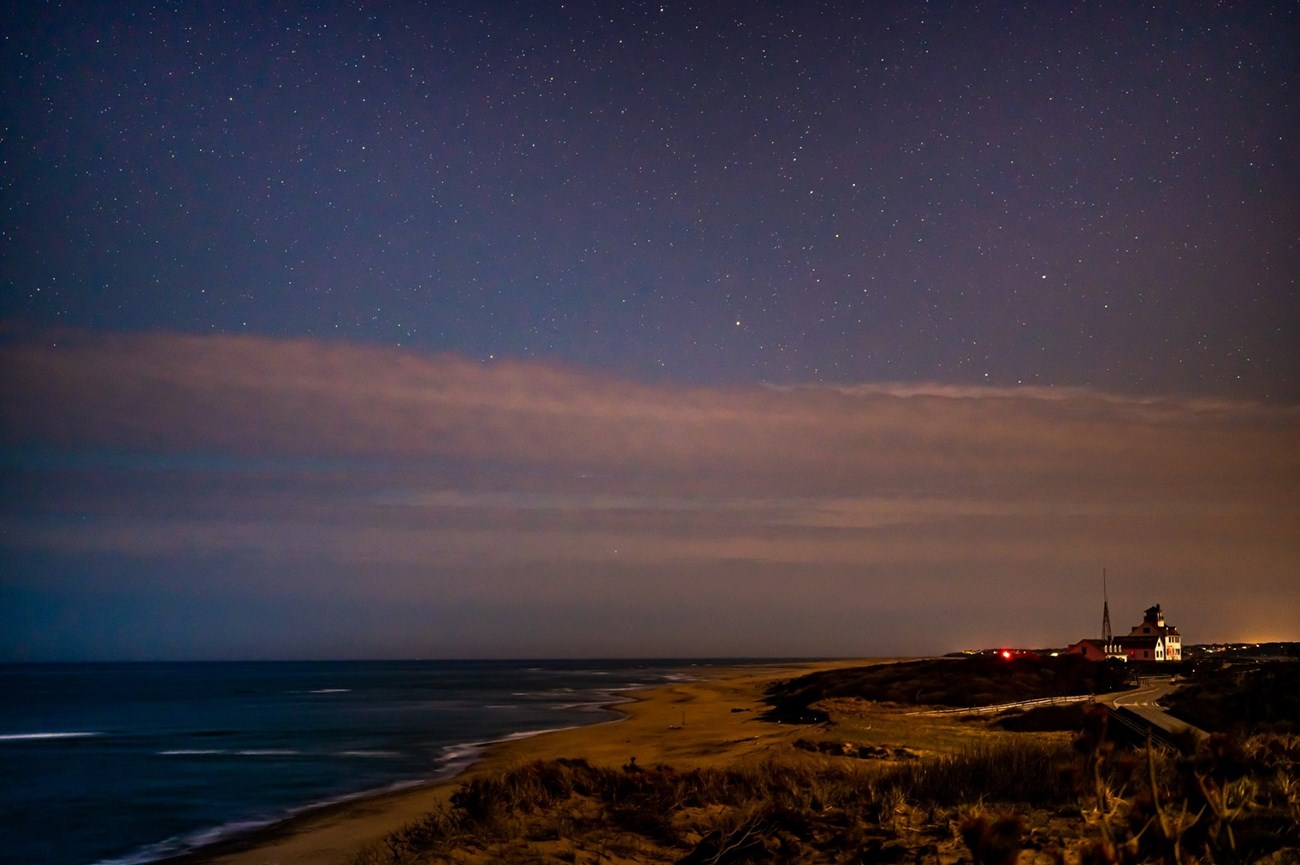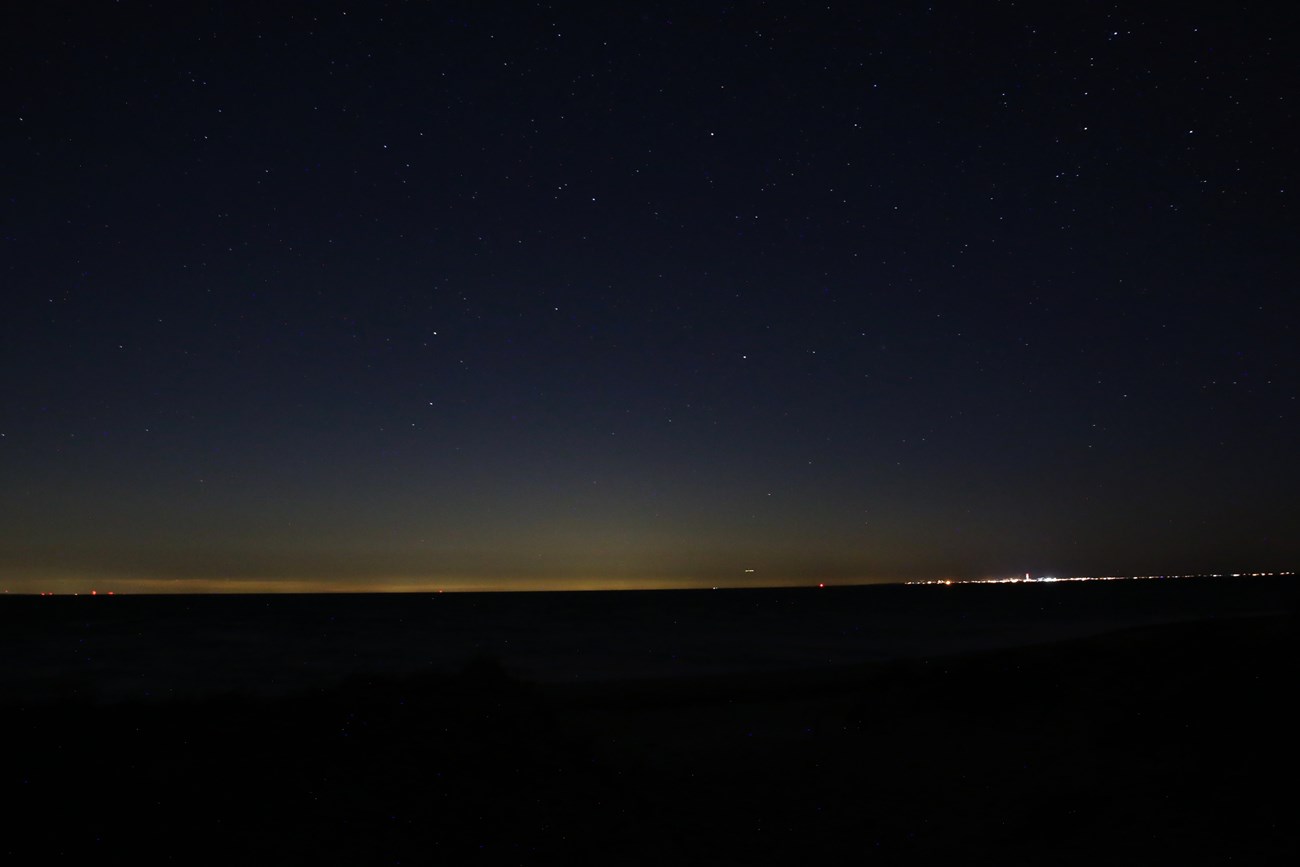Last updated: May 18, 2023
Article
Uncovering Our Night Skies

NPS Photo/D.Blankenship
Written by Lily Gooding, Americorps Cape Cod
Under the clearest and darkest night, the human eye can see between 5,000 to 7,000 stars. At Cape Cod National Seashore, one might be able to spot a couple hundred stars if they are lucky and maybe the milky way depending on the weather. But what if there was a way to see the complete “Starry Night” above the seashore? Like Van Gogh’s artwork, the night sky is full of swirled stars and colorful clouds connecting life on earth to the universe. Though it might seem out of reach, the reality is that a natural night sky can be restored.
Surrounded by ocean, but still close to the bright cities of Boston and Providence, the sky above Cape Cod National Seashore does not escape the shining lights. Like the salt marshes, dunes, and beaches of Cape Cod National Seashore, the natural night sky is tied to the health of a greater healthy ecosystem. It is for this reason that National Park Service sites across the country are investing in lighting fixtures with less exposure. However, the first step to restoring the natural darkness of the night sky is understanding why it is necessary.
Life on earth has evolved over time to follow the natural rhythm of the sun and moon cycle. Across the planet, there are many species that depend on the night sky for survival. Nocturnal bats are already threatened due to a harmful disease called white-nose syndrome. However, bats play an important role in insect control, feeding on night-flying bugs such as mosquitoes. Though bats depend on echolocation for direction and movement, an artificially bright sky especially at night can throw off their biological signaling, changing the feeding cycle and the food chain. Species that live in vernal pools look to the moon cycle for guidance on breeding time. Though the moon remains highly visible even with light pollution, artificial brightness can omit the same level of exposure equal to moonlight during certain phases. Some animals may mistake a light source for the moon, throwing off patterns of migration to the pools.
Other species may rely heavily on the stars for navigation. Migratory birds, for example, look to the stars for direction during flight. When the natural night sky is hidden, wildlife can be prone to harmful disorientation.
Even humans benefit from a naturally dark sky. Like other animals, humans originally operated daily life according to the light available. Health experts have found that artificial light sources, namely blue light like that which comes from phones and other devices, can disrupt humans’ ability to follow a regular sleep schedule. In extremes, unrestricted light can stand in the way of REM sleep which is important for the healthy function of the body and mind.
Many forms of life depend on the natural night sky. Since the invention of the lightbulb, human beings have altered outdoor landscapes and made viewing the natural nightscape hard to do. Instead of a beautiful array of natural light sources including bright stars, plants, the moon, and airglow, there is just blackness above. On the ground, even in the most remote places, one might look out at the night and see streetlights, outdoor lighting fixtures, dimmed bulbs guiding walkways, flood lighting, or motion-activated light. While these inventions have become important tools in every day human life, they are often installed without considering how light pollution could interfere with natural processes.

NPS Photo/Kristin Vinduska
Fortunately, the solution to restoring the natural night sky is simple. Unlike many other threatened natural resources, the preservation of the night sky does not require complex and costly approaches; in switching out bulbs, and altering the direction of the light, we can have full access to what some thought had disappeared.
Cape Cod National Seashore is undergoing the necessary steps to reduce light pollution parkwide. Members from the Natural Resources Stewardship and Sciences Directorate of the National Parks Service have visited Cape Cod three times since 2004 to conduct lighting assessments and measure the night sky conditions. Stationing at Marconi Overlook and Province Lands Visitor Center, the Night Sky team has recorded images of the night skies in 2004 and 2010. What the images capture is a small yet noticeable reduction in light pollution, suggesting that night sky-friendly lighting equipment is an effective strategy.
Most recently, members of the Night Sky team visited Cape Cod National Seashore in April of 2023. After surveying every lighting fixture on park lands, the team will offer alternative suggestions for infrastructure more suitable to protecting the natural night sky. Cape Cod National Seashore will plan to roll out these swaps as soon as possible.
But what can you do instead of a comprehensive lighting assessment? The good news is that light pollution is one of the easiest environmental challenges to resolve. The most effective way humans can influence reductions in light pollution is by turning off the lights. In the cases where that might be easier said than done, landowners can make small adjustments to their lighting type and direction, influencing a great impact.
When turning off the lights is not possible, facing outdoor lighting downward is the next best option. Installing shields on lights can be an effective way of achieving this. Another solution is setting timers and motion detectors that turn on lighting only when necessary. For a more involved solution, people can choose to invest in LED light bulbs with a warm color tone and temperature of less than or equal to 3000K. While LED light sources are significantly more efficient with energy emission, it is important to avoid blue light that appears much more artificial than warmer tones. In high use, blue light can disrupt human sleep patterns and habitual wildlife behavior.
With simple yet effective steps like these, real progress in restoring a natural night sky can be achieved. Not only is it better for the environment and wildlife, but a dark night sky is critical to ensuring human health and function. Fortunately, these recommendations are also cost-effective in saving energy, time, and money.
Cape Cod National Seashore is joined by many organizations on Cape Cod seeking to learn more and help spread awareness of night sky protection. Every year, the Seashore hosts anywhere from four to six Night Sky events. Led by rangers and other park employees, community members are invited to explore the beauty above. Perhaps Martin Luther King Jr. phrased it best when he said, “only when it is dark enough, can you see the stars.” A sight admired by astronomers, scientists, and wonderers alike feels so rare because of how infrequently we come across a sky untouched by artificial light. Fortunately, what once was is still; the same night sky tracked by the Mayans and charted by Galileo is right above our heads. What stands in our way of seeing it is not a new environment, but advances in technology and population that have upset the natural rhythm of day and night. While it may be hidden, the natural night sky glimmers and glows as it always has. It is up to us to uncover it now.


